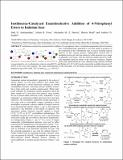Isothiourea-catalyzed enantioselective addition of 4-nitrophenyl esters to iminium ions
Date
02/02/2018Author
Grant ID
EP/J018139/1
EP/J018139/1
N/A
WM140071
Metadata
Show full item recordAbstract
Isothioureas catalyze the enantioselective addition of 4-nitrophenyl esters to tetrahydroisoquinoline-derived iminium ions. 4-Nitrophenoxide, generated in situ from initial N-acylation of the isothiourea by the 4-nitrophenyl ester, is used to facilitate catalyst turnover in this reaction process. Optimization showed that 4-nitrophenyl esters give the best reactivity in this protocol over a range of alternative aryl esters, with the observed enantioselectivity markedly dependent upon the nature of the iminium counteri-on. Highest yields and enantioselectivity were obtained using iminium bromide ions generated in situ via photoredox catalysis using BrCCl3 and Ru(bpy)3Cl2 (0.5 mol%) and commercially available tetramisole (5 mol%) as the Lewis base catalyst. The scope and limitations of this procedure was developed, giving the desired β-amino amide products in up to 96% yield, 79:21 dr and ermajor (2R,1′S) 99.5:0.5.
Citation
Arokianathar , J N , Frost , A B , Slawin , A M Z , Stead , D & Smith , A D 2018 , ' Isothiourea-catalyzed enantioselective addition of 4-nitrophenyl esters to iminium ions ' , ACS Catalysis , vol. 8 , no. 2 , pp. 1153-1160 . https://doi.org/10.1021/acscatal.7b02697
Publication
ACS Catalysis
Status
Peer reviewed
ISSN
2155-5435Type
Journal article
Description
The authors thank AstraZeneca and the EPSRC (grant codes EP/M506631/1; J.N.A. and EP/J018139/1; A.B.F.) for funding. The European Research Council under the European Union’s Seventh Framework Programme (FP7/2007-2013) ERC Grant Agreement No. 279850 is also acknowledged. A.D.S. thanks the Royal Society for a Wolfson Research Merit Award.Collections
Items in the St Andrews Research Repository are protected by copyright, with all rights reserved, unless otherwise indicated.

